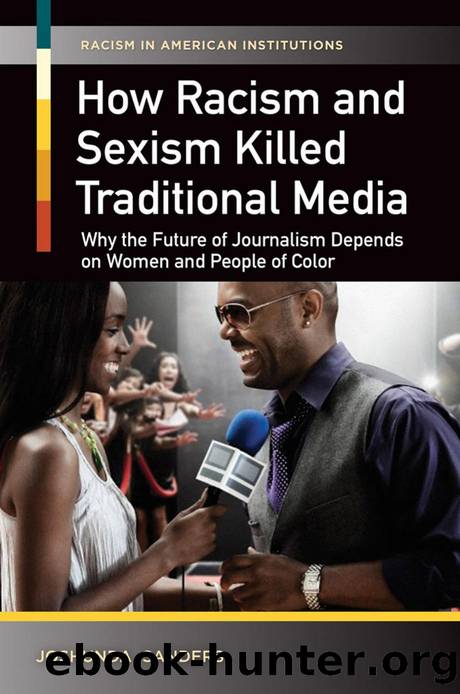How Racism and Sexism Killed Traditional Media: Why the Future of Journalism Depends on Women and People of Color by Joshunda Sanders

Author:Joshunda Sanders [Sanders, Joshunda]
Language: eng
Format: azw3, epub, mobi
Tags: Language Arts & Disciplines, Minority Studies, Social Science, Journalism, Anthropology, Cultural & Social, Media Studies, Race & Ethnic Relations
ISBN: 9781440830815
Publisher: Bloomsbury Academic
Published: 2015-08-11T06:16:51.559510+00:00
Chapter 5
The Apex of Inclusion
for Traditional Media
The Rise of a Multicultural Narrative within and
Outside of Legacy Media
The 1990s were the glory days for traditional media and the apex of
inclusion for women and people of color in newsrooms. This decade rep-
resented a full generation since the advent of serious widespread social
contemplation related to identity politics and the meaning of Americaâs
growing diversity. It also reflected the maturity of women and people of
color who had utilized the total spectrum of legal actions available to them
to respond to legacy media stalwarts determined to exclude them in hiring
and coverage.
The money companies made as the society they covered was raking in
largely borrowed cash was sometimes used, too, to augment newsroom
staffs with diverse hires or boost diversity programs and training to get pre-
dominately white institutions to commit to making their staffs look more
like their audiences. While the money was flowing, diversity for audiences
who so craved it seemed assured.
Nearly two decades after affirmative action became a codified part of the
American social infrastructure, newsrooms were also making a concerted
effort to make newsgathering more of a public, âcitizen journalistâ-friendly
zone. Print editions, additional products, and shows geared toward a mul-
ticultural audience cropped up, even as affirmative action backlash proved
a deterrent to these items. As media grew increasingly corporate and
profit-focused, the alternative press, along with subculture product that
accurately covered the marginalized, began to proliferate. This included
but was not limited to the emergence of zines as grassroots media spaces
where women, people of color, and people with alternate gender identi-
ties could explore everything that was generally missing from corporate
96 How Racism and Sexism Killed Traditional Media
mediaâfrom transgender bias and mental illness to rape culture, sexism,
and personal transformation stories.
Zines were an outgrowth of Riot Grrl culture and a subset of the alter-
native press that flourished as a precursor to widespread use of blogs and
social media. Zines also emerged during an American apex for ethnic and
cultural magazine publishing and growing cultural acknowledgment of hip
hop as a legitimate global and organizing force, including and apart from
its commercial aspects. These shifts coincided with a growing move toward
race and ethnicity as a focal point for stories instead of as afterthoughts.
As the analog predecessors for the power of individuals telling their sto-
ries before the Internet became ubiquitous, zines and their proliferation in
American culture made a statement about the ability of the traditionally
marginalized to center their narratives and define themselves outside of
the mainstream. These publications reinforce the notion that when women,
youth, and people of color frame their own narratives, the topics are myr-
iad, relevant, and a significant departure from how stories are framed about
them in traditional media spaces where their voices are largely absent.
These are stories of protest, whether related to war or inclusion in move-
ments where women of color are generally ignored.
It has to be noted that this is not the type of media, like social media or
blogs, that are financially viable or particularly sustainable. The power of
corporate, traditional media lies in their ability to attract advertising to pay
for news production and staffing. This is a luxury that small or
Download
How Racism and Sexism Killed Traditional Media: Why the Future of Journalism Depends on Women and People of Color by Joshunda Sanders.epub
How Racism and Sexism Killed Traditional Media: Why the Future of Journalism Depends on Women and People of Color by Joshunda Sanders.mobi
This site does not store any files on its server. We only index and link to content provided by other sites. Please contact the content providers to delete copyright contents if any and email us, we'll remove relevant links or contents immediately.
Autoboyography by Christina Lauren(4681)
Asking the Right Questions: A Guide to Critical Thinking by M. Neil Browne & Stuart M. Keeley(4586)
Dialogue by Robert McKee(3587)
Eat That Frog! by Brian Tracy(3521)
Sticky Fingers by Joe Hagan(3456)
Journeys Out of the Body by Robert Monroe(2993)
Elements of Style 2017 by Richard De A'Morelli(2945)
Annapurna by Maurice Herzog(2845)
Schaum's Quick Guide to Writing Great Short Stories by Margaret Lucke(2806)
Full Circle by Michael Palin(2780)
The Diviners by Libba Bray(2446)
The Art of Dramatic Writing: Its Basis in the Creative Interpretation of Human Motives by Egri Lajos(2416)
The Mental Game of Writing: How to Overcome Obstacles, Stay Creative and Productive, and Free Your Mind for Success by James Scott Bell(2396)
Why I Write by George Orwell(2361)
Atlas Obscura by Joshua Foer(2351)
In Patagonia by Bruce Chatwin(2274)
The Fight by Norman Mailer(2160)
The Elements of Style by William Strunk and E. B. White(2077)
Venice by Jan Morris(2052)
